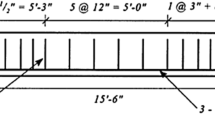Abstract
The majority of the published material models for unconfined concrete under uni-axial compression consist of two branches. The recent trend is to introduce empirical modification factors in the existing material models to improve agreement between experimental and analytical results, particularly for High Strength Concrete. This paper presents a compact analytical material model in which the available conditions uniquely determine all the model parameters. It consists of a single branch and the need for empirical factors is eliminated. An application of this material model to published experimental data on normal and lightweight concretes over a wide strength range demonstrates its versatility. The agreement between experimental and analytical results is as good as that which may be provided by any other existing model. The rationality and elimination of empiricism are additional gains.
Résumé
La majorité de modèles de matériaux publiés pour du béton non confiné sous compression uni-axiale sont constitués de deux parties. Une tendance récente est d'introduire des facteurs de modification empiriques dans les modèles de matériaux existants afin d'améliorer la concordance entre les résultats expérimentaux et analytiques, en particulier pour le béton à hautes performances. Cette étude présente un modèle de matériau compact et analytique dans lequel les conditions disponibles déterminent d'une manière unique tous les paramètres du modèle. Il est constitué d'une seule partie et les facteurs empiriques ne sont plus nécessaires. Une application de ce modèle de matériau à des données expérimentales publiées sur des bétons ordinaires et légers pour une large gamme de résistances démontre sa souplesse. La concordance entre les résultats expérimentaux et analytiques est aussi bonne que celle que peut fournir un autre modèle existant. La rationalité et l'élimination de l'empirisme sont des avantages additionnels.
Similar content being viewed by others
Abbreviations
- Alphabets: A, B, C, D:
-
Model parameters
- E:
-
Modulus
- e:
-
Error
- f:
-
Stress
- k:
-
Empirical modification factor
- N:
-
Number of data points
- n:
-
Model parameter
- m:
-
Derived quantity
- U:
-
Derived quantity
- X:
-
Dimensionless strain
- Y:
-
Dimensionless stress
- Subscrips: g:
-
General point
- O:
-
At origin
- P:
-
At peak point
- Greek letter: ε:
-
Strain
References
Hognestad, E., ‘A study of combined bending and axial load in reinforced concrete members’, Bulletin no 399, Engineering Experimental Station, University of Illinois, USA, 1951.
Smith, G.M. and Young, L.E., ‘Ultimate flexual analysis based on stress strain curve of cylinder’,ACI Journal, Proceedings 53 (6) (1956) 597–609.
Saenz, L.P., ‘Discussion of ‘Equation for the Stress strain curves of Concrete’ by Desai and Krishnan’.ACI Journal 61 (9) (1964) 1229–1235.
ACI Committee 318, ‘Building code requirements for reinforced concrete’, American Concrete Instite, USA, 1989.
Norges Byggstandardiseringsråd ‘Concrete Structures Design Rules’—NS 3473, Norway, 1989.
Collins, M.P., Mitchell, D. and MacGregor, J., ‘Structural design considerations for high strength concrete’,Concrete International 20 (1993) 27–34.
Wee, T.H., Chin, M.S. and Mansur, M.A. ‘Stress strain relationship of high strength concrete in compression’,Journal of Materials in Civil Engineering (ASCE) 8 (2) (1996) 70–76.
Popovics, S. ‘A numerical approach to the complete stress strain curve of concrete’,Cement and Concrete Research 3 (1973) 583–599.
Carreira, D. and Chu, K., ‘Stress-strain relationship for plain concrete in compression’,ACI Journal, Proceedings 82 (1985) 797–804.
Wang, P.T., Shah, S.P. and Naaman, A.E., ‘Stress-strain curves of normal and lightweight concrete in compression’,ACI Journal Proceedings 75 (11) (1978) 603–611.
Kumar, P., ‘A second order material model for unconfined conctete under uni-axial compression’,Indian Concrete Institute Journal 4 (2) (2003) 23–26.
Barr, S. and Lee, M.K., ‘Modeling the strain-softening behavior of plain concrete using a double exponential model’,Magazine of Concrete Research 55 (4) (2003) 343–353.
Author information
Authors and Affiliations
Rights and permissions
About this article
Cite this article
Kumar, P. A compact analytical material model for unconfined concrete under uni-axial compression. Mat. Struct. 37, 585–590 (2004). https://doi.org/10.1007/BF02483287
Received:
Accepted:
Issue Date:
DOI: https://doi.org/10.1007/BF02483287




